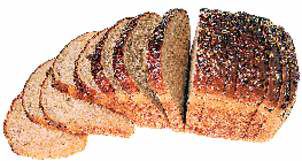White bread is out, whole grain is in
Published 5:00 am Friday, August 6, 2010

- Thinkstock
Whole grains are the hottest trend in sliced bread, with whole wheat edging out soft white bread in total sales for the first time.
Flooded with messages about heart health, fiber intake and the need for omega-3s, more consumers are looking for bread that can taste good and deliver nutrients.
Trending
That’s why shopping for sliced bread is increasingly about one of two things: what’s affordable, and what seems healthiest. And the breads in the middle of the market seem to be getting squeezed.
The best-performing breads are promoting credentials like “whole grain” and “natural,” sometimes asking consumers to pay more for those loaves. And it seems to be working. Breads with “natural” in the name, or grains visible through the packaging, are among the best performing at grocery stores. Among them: Nature’s Own, Nature’s Pride and Arnold.
It’s part of a major turning of the tide. Packaged wheat bread recently surpassed white bread in dollar sales, according to Nielsen Co. For the 52 weeks ended July 10, wheat bread sales increased 0.6 percent to $2.6 billion, while white bread sales declined 7 percent to $2.5 billion. White bread is still ahead in volume, but the margin is shrinking. Americans bought 1.5 billion packages of white bread in the last year, a 3 percent decrease, and 1.3 billion packages of wheat bread, a 5 percent increase.
Declining brands
The environment has been hard on midprice players. Among them, Downers Grove, Ill.-based Sara Lee, which has put its $2.2 billion bread business up for sale, people familiar with the matter say. The company declined to comment on the possibility of a sale.
Sara Lee-brand bread sales are down 10 percent over the last 52 weeks to $359 million, according to SymphonyIRI Group, a Chicago-based market-research firm. IRI figures do not include Wal-Mart.
Trending
Many other brands also are slipping, including Bimbo’s Oroweat, down 10 percent to $301 million, Hostess’ Wonder bread, down 5 percent to $220 million, and Bimbo’s Stroeh-mann, down 6 percent to $116 million.
Sliced-bread sales as a whole fell 3 percent, to $6.5 billion, over the same period.
Sara Lee had been the second-highest grossing bread brand at grocery stores, behind Campbell’s Soup Co.’s Pepperidge Farm, until it was surpassed in 2009 by Nature’s Own, a whole-wheat bread owned by Thomasville, Ga.-based Flower Foods. Nature’s Own sales are up 3 percent over the past year to $416 million.
New habits
Sharon Glass, group vice president of health and wellness at Catalina Marketing, said many consumers are trying whole-grain products, especially with more variety on shelves and less association with dry, dense breads of the past. She said some people will need coupons to get them to try a whole-grain bread, but once they find something they like, it will become a habit.
Samantha Dulles, a stay-at-home mom in Downers Grove, said since she found a whole-grain bread that her whole family enjoyed — Pepperidge Farm’s Farmhouse Soft Oatmeal bread — she has never bought anything else.
“It’s great if it’s on sale, but I don’t really worry about that,” she said.
Still, white bread isn’t dead.
Angela Saliani, of Rogers Park, mom to Christopher, 5, and Cassandra, 10 months, feeds her family Sara Lee’s white wheat bread. She buys wheat bread for herself, but partner Kirk O’Keeffe prefers sandwiches made with white bread. But it’s important to her that the family eat bread with some nutritional value.
Saliani said she isn’t brand-loyal in most cases, and she looks online for coupons before shopping to save money. Yet, if O’Keeffe is going to the grocery store, Saliani said she reminds him “don’t get the 99-cent bread, spend the $3 on the Sara Lee whole-grain white if you’re going to get white.”
Some consumers want healthier breads but are focused on price.
Kendra Frost, a first-time, single mother who owns a small business, said she’s working hard to keep grocery expenses down while also eating healthily.
“I like the whole grain, but I usually try and go with the least expensive whole grain,” Frost said. And since labels have gotten confusing, “I look for the thick pieces that you can see the grains on the top of the bread.”








